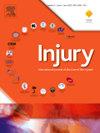Characterizing the epidemiology of traumatic ear injuries: A 20 year analysis of emergency department visits in the U.S
IF 2.2
3区 医学
Q3 CRITICAL CARE MEDICINE
Injury-International Journal of the Care of the Injured
Pub Date : 2025-03-26
DOI:10.1016/j.injury.2025.112287
引用次数: 0
Abstract
Background
The ear is one of the most technically difficult areas to reconstruct following traumatic injury. Utilizing the largest national multicenter patient sample to date, this study seeks to provide a critical overview of the epidemiology of traumatic ear injuries.
Methods
The NEISS database was searched from 2003–2022 to identify patients with related traumatic ear injuries. Three age groups were examined: geriatric (65+), adult (18–64), and pediatric (2–17). Variables including race, sex, incident location, commercial products involved, and emergency department disposition were evaluated between the groups utilizing two-proportion z-tests with Bonferroni correction.
Results
25,285 patients who sustained ear injuries were identified from the NEISS database. The top five types of ear injuries were laceration, contusion, puncture, hematoma, and burn. Geriatric patients experienced a significantly higher frequency of ear lacerations (82.5 % vs 68.6 %, p < 0.001) relative to non-geriatric adults, while children had a significantly greater frequency of hematomas (3.7 % vs 2.8 %, p = 0.001), and contusions (18.0 % vs 16.0 %, p = 0.006). The top five products involved for ear injuries were tables, first aid equipment, bed/bedframe, jewelry, and chairs. Geriatric adults had a significantly higher frequency of ear injuries from bed frames relative to non-geriatric adults (20.0 % vs 3.2 %, p < 0.001) and were over five times more likely to be admitted to the hospital..
Conclusions
This study offers novel insights into the epidemiology of traumatic ear injuries in the U.S especially across different age demographics. The greater prevalence of ear injuries from tables, first aid equipment, and with sporting activities among children highlights needs for childproofing homes and providing greater patient education and regulation on ear safety. The increased fragility of tissue and greater prevalence of fall injuries among geriatric patients demonstrates need for ongoing physical therapy and fall risk measures to be implemented. Collectively, the results help inform public health strategies to prevent such injuries as well as provide invaluable clinical context for reconstructive surgeons.
求助全文
约1分钟内获得全文
求助全文
来源期刊
CiteScore
4.00
自引率
8.00%
发文量
699
审稿时长
96 days
期刊介绍:
Injury was founded in 1969 and is an international journal dealing with all aspects of trauma care and accident surgery. Our primary aim is to facilitate the exchange of ideas, techniques and information among all members of the trauma team.

 求助内容:
求助内容: 应助结果提醒方式:
应助结果提醒方式:


